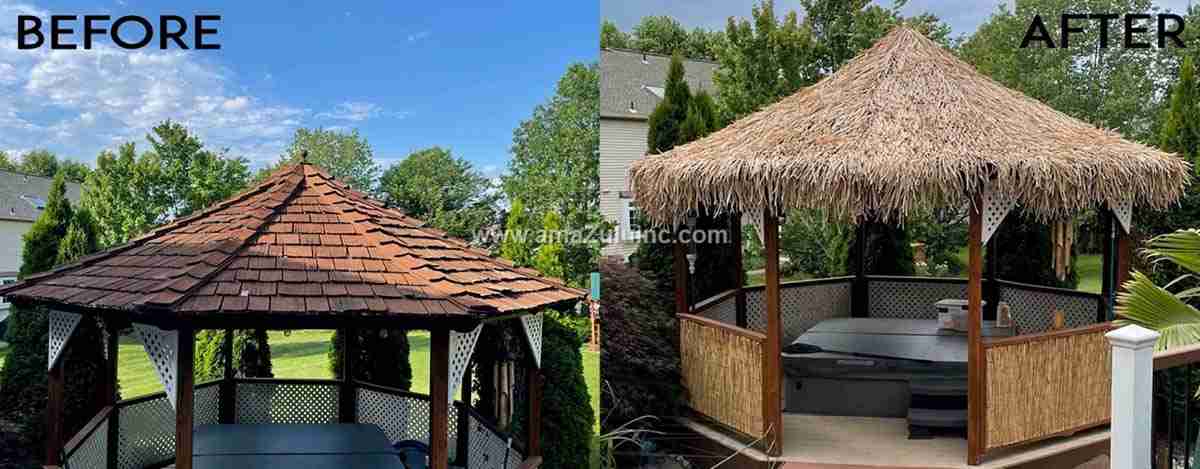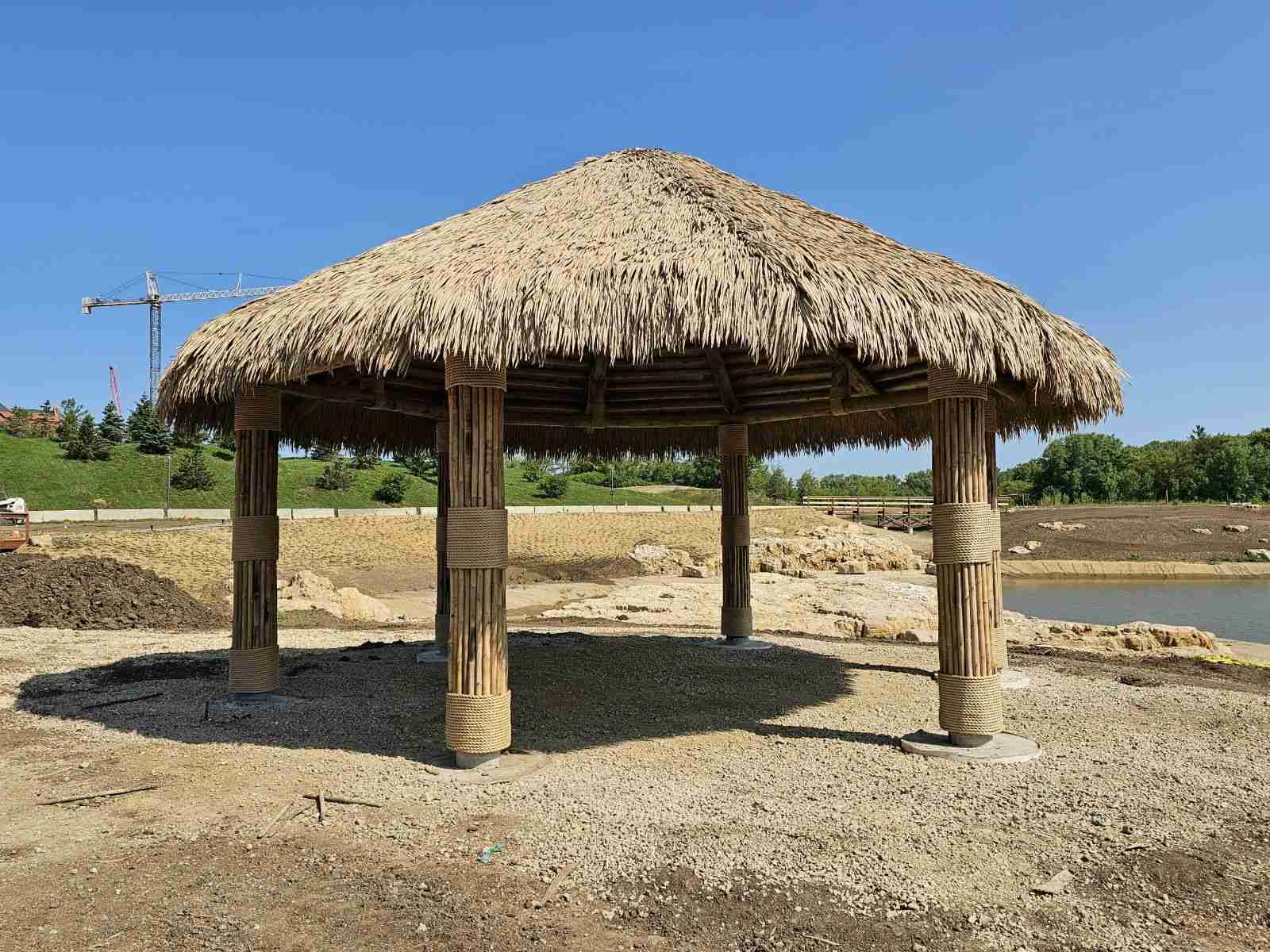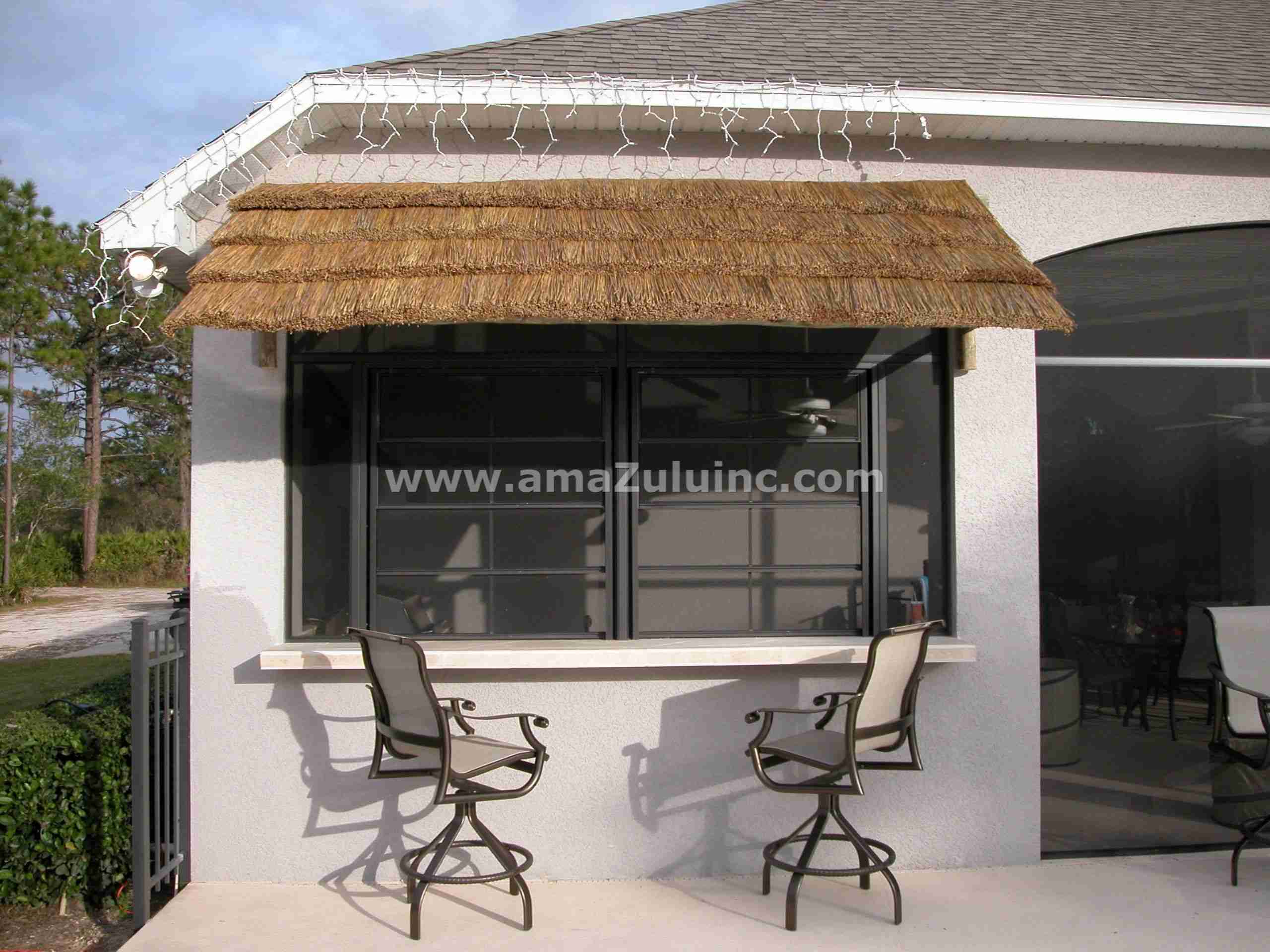Imagine walking through a tropical paradise, where the soft rustle of palm leaves overhead transports you to an exotic escape. This is the allure of thatched roofs, a design element that can transform a theme park or resort into an enchanting getaway.
The natural charm and rustic beauty of thatch create an authentic atmosphere that captivates visitors and enhances their experience. However, choosing the right thatch roofing material is very important to ensure your roof has longevity in addition to visual appeal.
This guide will explore the best options for thatched roof materials suitable for theme parks and resorts. From natural choices like Mexican rain cape and Tahitian thatch to modern synthetic alternatives, we will examine the pros and cons of each to help you make an informed decision for your project.
Option 1: Natural Mexican Rain Cape
The Mexican rain cape is one of the most affordable options for thatched roofing. It is crafted from palm leaves, intricately woven into sheets using a traditional method originating from a single village in Mexico.
This centuries-old technique has been passed down through generations, allowing the rain cape to retain its suppleness and flexibility. Historically, these capes were used as protective garments against the rain, giving them their name.
“Mexican rain cape is probably the most affordable in the whole cosmos,” says Tristan Ishtar, vice president of sales at amaZulu. “It looks great, but in Florida, you might get a year, maybe two years out of it because it’s going to break down really, really quickly. But if you use it inside, like a lot of restaurants, it’ll last forever.”
Pros
- Affordability: Mexican rain cape is the least expensive option, costing only a little over $1 per square foot.
- Ease of Use: Its lightweight nature makes it easy to install, especially in less structurally demanding settings.
Cons
- Limited Outdoor Durability: Outdoors, this material is not waterproof and quickly decomposes. Exposure to rain and UV light accelerates its breakdown.
- Not Suitable for Heavy-Duty Use: Due to its fragility and short lifespan, it is not recommended for major commercial applications where durability is a priority.
Ideal Uses
The Mexican rain cape is best suited for indoor environments or temporary outdoor installations where its affordability and easy application are advantageous. It is ideal for creating a tropical ambiance in restaurants or for temporary structures like small backyard tiki huts.
Option 2: Tahitian Thatch Panels
Tahitian thatch panels are a step up in durability and functionality from the Mexican rain cape. These panels are crafted from palm thatch, which is thicker and denser, resembling shingles in their structure. Each panel is typically three feet long and two feet high, providing substantial coverage with a thick, chunky texture that offers visual and physical depth.
Pros
- Enhanced Waterproofing: The overlapping design of Tahitian thatch panels provides excellent waterproofing, with double coverage that achieves about 95-96% rain resistance. This feature makes them well-suited for outdoor use in tropical environments.
- Extended Lifespan: With proper installation and maintenance, Tahitian thatch can last 7-8 years, offering more longevity compared to lighter, less durable natural options.
Cons
- Maintenance Requirements: To ensure maximum lifespan, regular maintenance is necessary. This includes occasional sealing and ensuring that the panels remain securely fastened.
- Higher Cost: Compared to the Mexican rain cape, Tahitian thatch panels are more expensive due to their enhanced quality and durability.
Ideal Uses
Tahitian thatch panels are ideal for outdoor structures that require a balance between natural aesthetics and durability, such as tiki huts, umbrellas, pavilions, and cabanas in tropical-themed resorts. Their robust design and weather-resistant properties make them a practical choice for locations that experience frequent rain or humidity.
Option 3: Thatch Reed Panels
Thatch reed panels, also known as African reed thatch, are crafted from reeds bound together with a flexible urethane top. This unique construction makes them nearly waterproof, offering a refined thatch appearance for both indoor and outdoor use. These panels provide an elegant and sophisticated alternative to traditional palm thatch, with a sleek and uniform look.
Pros
- Effective Waterproofing: When installed properly, thatch reed panels are 99% waterproof, making them suitable for outdoor applications where moisture resistance is essential.
- Temperature Regulation: These panels are 5% to 10% cooler than regular shade materials, providing natural temperature regulation in hot climates.
Cons
- Limited Lifespan: Thatch reed panels typically last between four and five years, depending on the climate, with better performance in hot, dry conditions.
- Weight Considerations: Each panel weighs approximately 10 lbs, which may require additional structural support during installation.
Ideal Uses
Thatch reed panels are ideal for creating a refined thatch roof appearance in outdoor paradises such as luxury resorts and high-end residential properties. They are also suitable for interior applications where their aesthetic and temperature-regulating properties can be fully appreciated, especially under a thatch reed umbrella.
Option 4: Synthetic Thatch
Synthetic thatch is a modern solution designed to replicate the appearance of natural thatch while offering superior durability and low maintenance. Made from high-quality materials such as plastic, synthetic thatch is engineered to withstand the harshest weather conditions, making it a reliable choice for both commercial and residential applications.
It is available in various styles to mimic different types of natural thatch, providing aesthetic flexibility for design projects.
“We only carry synthetic thatch that’s passed UV sun exposure testing and wind-rated up to 110 miles an hour,” Tristan says. “We have installations at Disney that have been up 20 years, and it looks just as good as when they put it in. That’s what our customers want with commercial applications: at least 15 to 20 years, no maintenance, no hassle.”
Pros
- Exceptional Durability: Synthetic thatch is incredibly durable, often lasting 15 to 20 years without requiring maintenance. It is resistant to UV rays, wind, and fire, ensuring a long-lasting installation.
- Low Maintenance: Unlike natural thatch, synthetic options do not rot, attract pests, or require regular upkeep. Once installed, they offer a hassle-free solution that maintains its appearance over time.
Cons
- Higher Initial Cost: The upfront cost of synthetic thatch can be higher than natural alternatives, which may be a consideration for budget-conscious projects. However, due to their attributes, they will save money in the long run.
Ideal Uses
Synthetic thatch is ideal for large-scale commercial applications where longevity and minimal maintenance are key priorities. It is perfect for theme parks, resorts, and zoos that require a durable, weather-resistant roofing solution. Its ability to withstand harsh climates and intense sun exposure makes it a popular choice for tropical-themed environments.
Get Expert Help for Thatch Roofing on Your Next Project
Choosing the right thatched roofing material is crucial for achieving the desired look and longevity for your project. amaZulu offers a wide range of high-quality thatch options, from natural palm thatch to advanced synthetic solutions, each designed to meet the specific needs of your theme park or resort.
As you can see, there are several different options for thatch roofing, each with their own benefits and potential downsides, and the right choice will heavily depend on your project. As a result, the best idea is to talk to us at amaZulu.
Our team of experts is ready to assist you in selecting the perfect thatch solution for your next construction project, ensuring beauty, durability, and functionality for years to come. Contact us for a free consultation today.





